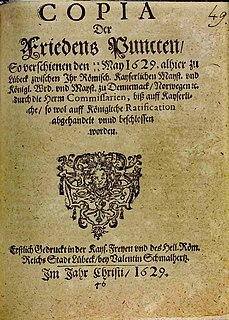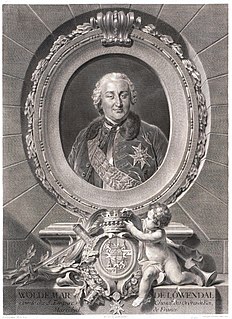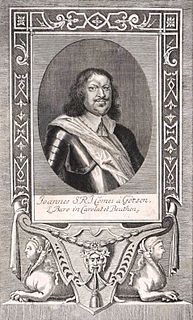
Ferdinand II was Holy Roman Emperor, King of Bohemia, Hungary, and Croatia from 1619 until his death in 1637. He was the son of Archduke Charles II of Inner Austria and Maria of Bavaria. His parents were devout Catholics, and, in 1590, they sent him to study at the Jesuits' college in Ingolstadt because they wanted to isolate him from the Lutheran nobles. In July that same year (1590), when Ferdinand was 12 years old, his father died, and he inherited Inner Austria–Styria, Carinthia, Carniola and smaller provinces. His cousin, the childless Rudolf II, Holy Roman Emperor, who was the head of the Habsburg family, appointed regents to administer these lands.

Ferdinand III was from 1621 Archduke of Austria, King of Hungary from 1625, King of Croatia and Bohemia from 1627 and Holy Roman Emperor from 1637 until his death in 1657.

Albrecht Wenzel Eusebius von Wallenstein, also von Waldstein, was a Bohemian military leader and statesman who fought on the Catholic side during the Thirty Years' War (1618–1648). His successful martial career made him one of the richest and most influential men in the Holy Roman Empire by the time of his death. Wallenstein became the supreme commander of the armies of the Imperial Army of Holy Roman Emperor Ferdinand II and was a major figure of the Thirty Years' War.

Matthias Gallas, Graf von Campo und Herzog von Lucera was an Austrian professional soldier during the Thirty Years' War. He distinguished himself in the first half of the war in service of the Catholic League, in the War of the Mantuan Succession, and as one of Albrecht von Wallenstein's Generals. After carrying out the dismissal and elimination of Wallenstein, Gallas became acting supreme commander of the Imperial Army three times between 1634 and 1647 but he never held the function or authority of a Generalissimo.

Peter Ernst, Graf von Mansfeld, or simply Ernst von Mansfeld, was a German military commander who, despite being a Catholic, fought for the Protestants during the early years of the Thirty Years' War. He was one of the leading mercenary generals of the war.

Charles Bonaventure de Longueval, 2nd Count of Bucquoy was a military commander who fought for the Spanish Netherlands during the Eighty Years' War and for the Holy Roman Empire during the Thirty Years' War.

Ottavio Piccolomini, 1st Duke of Amalfi was an Italian nobleman whose military career included service as a Spanish general and then as a field marshal of the Holy Roman Empire.

The Battle of Lutter took place on 27 August 1626 during the Thirty Years' War, south of Salzgitter, in Lower Saxony. A combined Danish-German force led by Christian IV of Denmark was defeated by Johan Tzerclaes, Count of Tilly, commanding an army of the Catholic League loyal to Emperor Ferdinand II.

The Battle of Dessau Bridge was a significant battle of the Thirty Years' War between Danish Protestants and the Imperial German Catholic forces on the Elbe River outside Dessau, Germany on 25 April 1626.

Peter Ernst I von Mansfeld-Vorderort was a Spanish Imperial army commander of German origin and Governor of the Spanish Netherlands from 1592 to 1594.

Treaty or Peace of Lübeck ended the Danish intervention in the Thirty Years' War. It was signed in Lübeck on 22 May 1629 by Albrecht von Wallenstein and Christian IV of Denmark, and on 7 June by Ferdinand II, Holy Roman Emperor. The Catholic League was formally included as a party. It restored to Denmark–Norway its pre-war territory at the cost of final disengagement from imperial affairs.

The siege of Stralsund was a siege laid on Stralsund by Albrecht von Wallenstein's Imperial Army during the Thirty Years' War, from May to 4 August 1628. Stralsund was aided by Denmark and Sweden, with considerable Scottish participation. The lifting of the siege ended Wallenstein's series of victories, and contributed to his downfall. The Swedish garrison in Stralsund was the first on German soil in history. The battle marked the de facto entrance of Sweden into the war.

John Frederick of Schleswig-Holstein-Gottorp was the Lutheran Administrator of the Prince-Archbishopric of Bremen, the Prince-Bishopric of Lübeck and the Prince-Bishopric of Verden.

Ulrich Friedrich Woldemar Graf von Löwendal was a German officer and statesman.

The House of Mansfeld was a princely German house, which took its name from the town of Mansfeld in the present-day state of Saxony-Anhalt. Mansfelds were archbishops, generals, supporters as well as opponents of Martin Luther, and Habsburg administrators.

Torquato Conti (1591–1636) was an Italian military commander who served as a General-Field Marshal of the Holy Roman Empire during the Thirty Years' War. His barbarous treatment of defenceless villagers earned him the nickname, The Devil. He later became a nobleman and was made Duke of Guadagnolo and Gonfalonier of the Church by Pope Urban VIII.
The Battle of Wismar took place on December 5, 1711 close to Wismar, Swedish Empire during the Great Northern War. A 3,000 strong Danish force under the command of Jørgen Rantzau blocked the Swedish city of Wismar. The Swedes under Martin von Schoultz, sent out 2,500 men from their garrison in an attempt to surprise the Danish forces camping a distance away. However, the Danish commander got words of the approaching Swedes and countered them, resulting in 478 Swedes dead, with another 1,500 captured to only 300 Danes killed and wounded.

Johann von Götzen was a Lüneburg nobleman and Generalfeldmarschall who fought during the Thirty Years' War. He was married to Elisabeth of the Falke family, with whom he had two sons: Johann Sigismund, Count of Götzen (1622-1622) and Johann, Georg Count of Götzen (1623-1679).

Johann Philipp Kratz von Scharffenstein was a German nobleman and field marshal, who fought during the course of the Thirty Years' War. He served with distinction in forces of both the Catholic League and Holy Roman Empire. His poor relationship with the Imperial generalissimo Albrecht von Wallenstein frustrated his plan of becoming the supreme commander of the League's forces. Embittered by this he defected to Sweden, where he attained the rank of field marshal. He was captured at the Battle of Nördlingen in 1634 and executed for treason a year later.




















